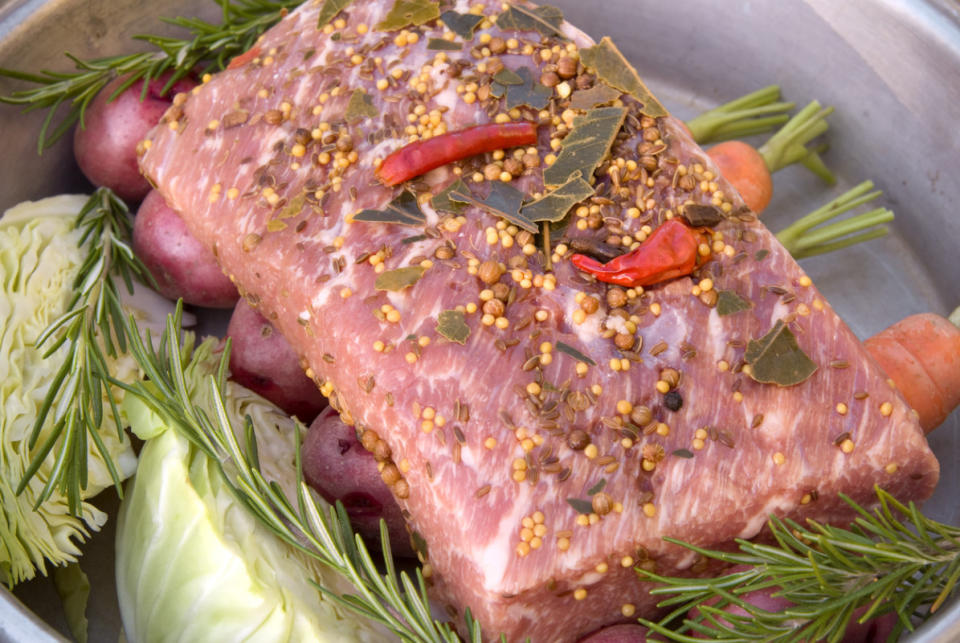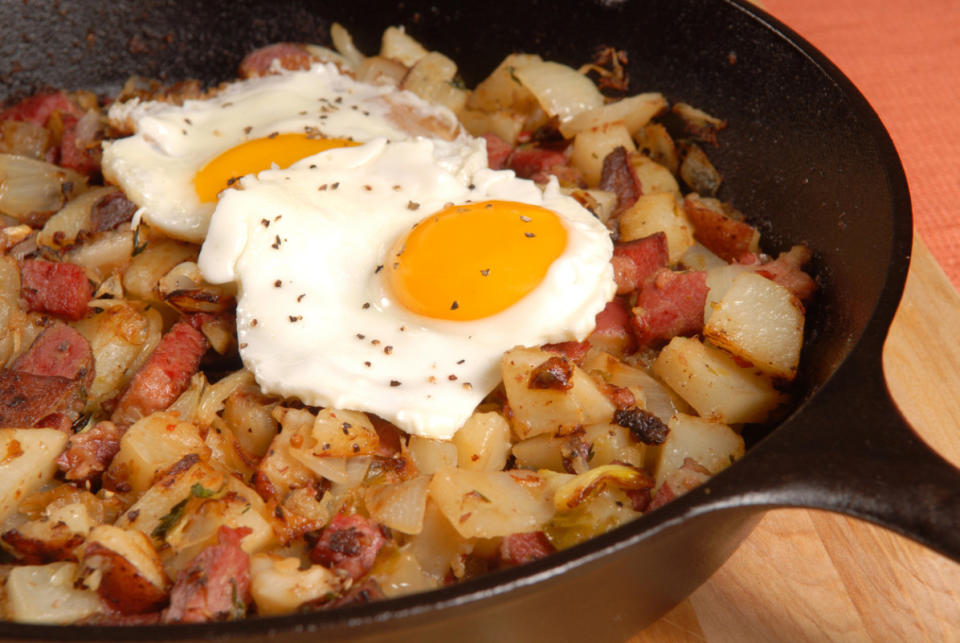Corned Beef Isn't as Irish as You Might Think—Here's What You Need to Know

- Oops!Something went wrong.Please try again later.
Corned beef and cabbage plate
Is there anything that says St. Patrick’s Day more than corned beef and cabbage with a pint of Guinness? We think not.
In fact, according to Supermarket News, as much as 90% of its corned beef sales in the U.S. happen in the week prior to St. Paddy’s. (Nope, it's not St. Patty's. Here's why.)
But, while corned beef has become synonymous with St. Patrick’s Day in America, you may be surprised to learn that it's not all that common in Ireland and its culinary roots are actually more Jewish than Irish (hello, Reuben sandwich).
So what is corned beef? To find out what you need to know about this St. Patrick's Day staple, we dug into the history of the dish and talked with a historian who specializes in Irish American history. Grab a Guinness, sit back—and enjoy the story.

iStock
What Is Corned Beef?
Rumor has it the term corned beef was invented by the British in the 17th century, but in the following centuries was widely adopted across Europe, especially within the Jewish community—a culinary tradition they brought with them when they immigrated to America.
The Irish connection can be traced back to the late 19th and early 20th centuries when Irish immigrants in New York City's Lower East Side often lived in close proximity to Jewish immigrants from Europe, says Elizabeth Stack, PhD, consultant historian at the Irish American Heritage Museum.
Why Is It Called Corned Beef?
Despite what the term may lead you to believe, corned beef doesn’t involve corn. “Corning” means curing —or preserving—meat with small crystals of salt, or "corns," explains Stack.
Related: 13 New Ways to Prepare Corned Beef
What's the Story Behind Corned Beef?
In the late 1800s and early 1900s, when huge waves of both Irish and Jewish immigrants were pouring into New York City via Ellis Island, beef was relatively inexpensive.
“In the late nineteenth century, as German and Jewish prototypical delis started to show up in the Lower East Side, corned beef was relatively cheap at the local Jewish butcher shops, and tasted similar, so Irish immigrants made a substitution that stuck,” says Stack, and combined it with other inexpensive staples like cabbage and potatoes. Over time, corned beef and cabbage became an Irish-American classic and a must for St. Patrick's Day celebrations in the United States.
Related: What's So Great About Irish Butter?

iStock
What Is Corned Beef Brisket?
In modern times, whether you DIY your corned beef at home or purchase it at the supermarket, it’s brined with pink curing salt, which is sodium nitrite.
In addition to the salt, corned beef is cured with water, brown sugar and a spice blend of garlic, coriander, allspice, black pepper and bay leaves, which gives it its signature taste. If this spice blend sounds familiar, it’s because it’s the same combo that's used in pickling.
“Probably traditionally, the spices used might have been a bit different… heavier pickling spices like cloves, mustard seed and other traditional pickling spices will predominate on the Irish style and it is sliced thicker,” explains Stack, while “the Jewish style is drier, with heavy garlic and onion-y flavors.”
Corned beef i usually cooked in a slow cooker (get our recipe for the best slow cooker corned beef and cabbage here) or over low heat on the stovetop in a Dutch oven for ultra-tender results. Essentially, corned beef brisket is pickled beef that’s then cooked low and slow.
By the way, pastrami starts out the same way: with a brined and cooked corned beef brisket. But pastrami isn’t done there (though some say pastrami was actually a Romanian creation long before it became a Jewish deli staple).
Related: Pastrami vs. Corned Beef—What's the Difference?
Is Corned Beef Popular in Ireland?
Irish Americans may dance a jig for corned beef on St Patrick's Day, but their Irish counterparts don’t actually eat much of it. According to Stack, in Ireland, cows historically earned their keep through fieldwork or dairy duties, and only ended up on the dinner table after they'd hung up their plows.
“While Ireland had a thriving salted-beef export business in the 17th and 18th centuries, beef wasn’t widely eaten in Ireland by Catholic peasants, but was quite popular among the Anglo Irish and landlord class, says Stack. “But it was still likely seen as a luxury product and poorer families would rarely have eaten meat at all, except perhaps from pigs, which were plentiful,” she adds.
In Ireland itself, the traditional dish associated with St. Patrick's Day is actually bacon and cabbage, reflecting the historical availability of pork rather than beef in Irish cuisine.
Related: 52 Easy Irish Recipes
What Part of the Cow is Corned Beef?
The traditional cut used to make corned beef is brisket, which comes from the front or breast area of the cow. The cut can be a bit tough but has a delicious beefy flavor. The corning (or brining) process tenderizes the brisket so you end up with a piece of meat that basically melts in your mouth after being cooked low and slow.
Related: Best-Ever Crock Pot Irish Stew Recipe
What is the Best Cut for Corned Beef?
If you’re brining your own corned beef at home, rather than purchasing it pre-cured from the grocery store, you may wonder if there’s a particular cut of beef brisket you should look for, and indeed there is.
There are two cuts of beef brisket: the point cut and the flat cut. The point cut lays on top of the flat cut, which tends to be more even than the point cut. The more even point cut cooks more evenly, which makes it the preferred cut of brisket to use for corned beef.

iStock
What is Corned Beef Hash?
Derived from the French word “hacher,” meaning “to chop,” the English have used hash since the 1400s and it may have been slang for bad food, says Stack.
Regardless of its potentially dubious past, hash is a great way to use up leftovers—and corned beef is no different.
Just chop up your cooked corned beef and fry it up with onions, potatoes and even your cabbage and there you have it! Corned beef hash. Even better: Top it with a fried egg.
Fun fact: In the mid 1800s, a cheap restaurant was called a "hash house" or "hashery."
Related: 17 Brunch-Worthy Recipes
What Should You Serve With Corned Beef?
While cabbage and potatoes are traditional corned beef sides and are traditionally Irish, soda bread—which is delicious for mopping up juices from your corned beef and cabbage—may not be. “Soda bread may have been an American invention and not an Irish one since baking soda was invented in America,” says Stack.“So when you are eating corned beef and soda bread on St. Patrick's Day, you are truly taking part in an immigrant tradition, rather than an old Irish one,” she adds.
Related: Best Irish Soda Bread
Other Interesting Corned Beef Facts
Corned beef has had plenty of famous fans throughout history.
To name a few…
• According to the official website of Mount Vernon (the long-time home of president George Washington), First Lady Martha Washington often served cold corned beef for breakfast.
• It also famously appeared on Abraham Lincoln’s “Inaugural Luncheon Menu” held on March 4, 1861, along with Mock Turtle Soup, Parsley Potatoes, Blackberry Pie and Coffee.
• And last but not least, Astronaut John Young, who got in trouble with NASA for smuggling a corned beef sandwich onto the Gemini III in 1965 for its 5-hour orbit in space.
Up next: 10 Classic St. Patrick's Day Irish Recipes You Can Make in Your Crock Pot

